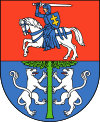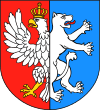Lubartów
Coordinates: 51°28′N 22°36′E / 51.467°N 22.600°E
| Lubartów | ||
|---|---|---|
|
Old Town Square in Lubartów | ||
| ||
 Lubartów | ||
| Coordinates: 51°28′N 22°36′E / 51.467°N 22.600°E | ||
| Country |
| |
| Voivodeship | Lublin | |
| County | Lubartów County | |
| Gmina | Lubartów (urban gmina) | |
| Established | 1543 | |
| Town rights | 1543 | |
| Government | ||
| • Mayor | Janusz Bodziacki | |
| Area | ||
| • Total | 13.91 km2 (5.37 sq mi) | |
| Population (2006) | ||
| • Total | 22,950 | |
| • Density | 1,600/km2 (4,300/sq mi) | |
| Time zone | CET (UTC+1) | |
| • Summer (DST) | CEST (UTC+2) | |
| Postal code | 21-100 | |
| Area code(s) | +48 81 | |
| Car plates | LLB | |
| Website | http://www.lubartow.pl | |
Lubartów (Polish pronunciation: [luˈbartuf]) is a town in eastern Poland, with 23,000 inhabitants (2004), situated in Lublin Voivodeship. It is the capital of Lubartów County and the Lubartów Commune. Historically it belongs to Lesser Poland, and from its beginnings, until 1795, was part of Lesser Poland’s Lublin Voivodeship. Lubartów was established in 1543 by Piotr Firlej under a founding order issued by King Sigismund the Old. At that time, it was a center of Protestant Reformation culture and education, following the founding of a school of Wojciech Calissius (1559).
The town is located 26 kilometres (16 miles) north of Lublin, on the Wieprz river, on the border between two geographical regions of Poland - Lublin Upland, and South Podlasie Lowland. Near Lubartów, the Kozłowiec Landscape Park (Kozłowiecki Park Krajobrazowy) is located. The town is the 10th largest urban center of the voivodeship, and its area is 13.92 square kilometres (5.37 sq mi). It is a road hub, where National Road nr. 19 (Rzeszów - Białystok) meets local road nr. 815. Furthermore, Lubartów is located along rail line nr. 30 (Łuków - Lublin), but since 2000, passenger traffic has been cancelled on this route. Lubartów is home to a sports club Lewart, founded in 1923.
The town's original Polish name was Lewartów (pronounced [lɛ'vartuf]) until 1744, when it was changed to Lubartów. Yiddish language, however, retains the original name Lewartów to this day (but pronounced ['lɛvatof]).
History

The history of Lubartów begins on May 29, 1543, when King Sigismund the Old allowed local nobleman Piotr Firlej to found a town called Lewartów (the original name comes from Lewart, the coat of arms of the Firlej family). The town became famous when it belonged to Mikołaj Firlej, the son of Piotr Firlej. In the late 16th century, it was one of centers of Calvinism in Lesser Poland, and Mikołaj Firlej invited here a number of skilled artisans from France, Germany and Holland, as well as cattle breeders. Lewartów frequently changed owners. In the early 18th century it belonged to the Sanguszko family, who rebuilt the palace, built two Baroque churches and tenement houses. Upon request of Paweł Karol Sanguszko, on November 22, 1744, King Augustus III of Poland changed the name of the town to Lubartów (in honor of Lubart - Liubartas, the son of Lithuanian Prince Gediminas; Sanguszko believed that Liubartas was the founder of his family). King Augustus granted a new coat of arms to the town. The 19th century was not lucky for Lubartów, as the town, which from 1815 to 1915 belonged to Russian-controlled Congress Poland, burned several times (1831, 1838, 1846). In 1866 it became the seat of a county, and slowly began modernization. By 1912 it had seven manufacturing enterprises, including mills and a brewery, in 1922, glassworks were opened.
Jews of Lubartów
From its foundation until World War II, the town also had a large Jewish community, numbering nearly half of the population in the 1930s. However nearly the entire community was destroyed during the Holocaust. Lubartów was a bilingual town for most of its history, Polish and Yiddish being both widely used. Polish was used among non-Jews as well as for most communication between Jewish and non-Jewish townspeople, while Yiddish was the everyday language of the town's Jewish inhabitants.
Points of interest
Among most interesting points of interest is the Sanguszko Palace (18th century). The original palace was built in the mid-16th century as a fortified residence. In 1693 architect Tylman van Gameren created a plan for rebuilding of the palace, and in 1705, the complex was partially burned during the Great Northern War. The palace was rebuilt, and burned again in 1933. Rebuilt in 1950-1970, it now is home to starosta of Lubartów County. Another interesting object are: Baroque St. Anne Basilica (1733-1738), and the monastery of Order of Friars Minor Capuchin (1737-1741).
International relations
Twin towns — Sister cities
Lubartów is twinned with:
Noted residents
- Bolesław Prus
- Jan Kochanowski
- Rafał Patyra
- Martin Dudzik
See also
- Lubartów Ghetto
- Sanguszko family
- Coat of arms of Lewart
- Lewart Lubartów - football club
- Wieprz
| Wikimedia Commons has media related to Lubartów. |

